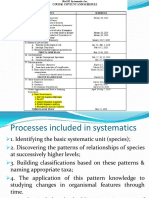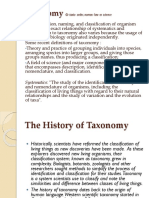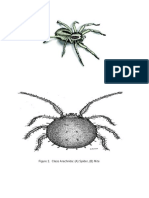01/02/2023
SYSTEMATICS
Lecture 1
WHAT IS SYSTEMATICS?
1
� 01/02/2023
SYSTEMATICS
The study of biological
diversity and evolutionary
relationships among organisms,
both extinct and modern.
SYSTEMATICS
attempts to organize
species into clades, which
means that each group
includes an ancestral
species and all of its
descendants.
2
� 01/02/2023
Example
Biologists reconstruct
phylogenies like that in
Figure 26.2 using
systematics
MOLECULAR SYSTEMATICS
A field of study that involves
the analysis of genetic data,
such as DNA sequences, to
identify and study genetic
homology and construct
phylogenetic trees.
3
� 01/02/2023
MOLECULAR SYSTEMATICS
• One goal of modern systematics is to create
taxonomic groups that reflect evolutionary
relationships.
PHYLOGENETIC TREE
4
� 01/02/2023
WHAT IS TAXONOMY?
TAXONOMY
field of biology that is concerned
with the theory, practice, and rules
of classifying living and extinct
organisms and viruses.
5
� 01/02/2023
• Taxonomy places all living organisms into progressively smaller
hierarchical groups called TAXA.
• The broadest groups are the three domains, called Bacteria, Archaea,
and Eukarya, followed by supergroups, KINGDOMS, PHYLA, CLASSES,
ORDERS, FAMILIES, GENERA, AND SPECIES.
• Binomial nomenclature provides each species with a scientific name that
refers to its genus and species epithet.
6
� 01/02/2023
GRAY WOLF
The felines are a subset of the animal group,
which has species that share many similar
traits.
The species that are placed together into
small taxonomic groups are likely to share
many of the same characteristics.
7
� 01/02/2023
Living Organisms Are Now Subdivided into Three Domains of Life
Modern taxonomy places species into progressively
smaller hierarchical groups.
Each group at any level is called a taxon(plural, taxa).
The taxonomic group called the kingdom was
originally the highest and most inclusive.
SYSTEMATICS VERSUS
TAXONOMY
1. Definition of terms
SYSTEMATICS
• refers to the scientific study and
classification of organisms for determination
of the evolutionary relationship of organisms
TAXONOMY
• refers to describing, naming, and classifying
of organisms
8
� 01/02/2023
NOMENCLATURE AND CLASSIFICATION
1. Definition of terms
NOMENCLATURE CLASSIFICATION
assigning organisms to a
group or taxa after thorough
assigning correct biological
analysis of traits
names to organisms
(morphological,
following scientifically
physiological, genetic, etc)
accepted standards
to best reflect evolutionary
relationships
SYSTEMATICS AND TAXONOMY OVERLAPS
1. Definition of terms
Both taxonomy and systematics study the
diversification and relationships of living organisms
Both taxonomy and systematics are involved in
characterizing organisms
Both taxonomy and systematics use morphological,
behavioral, genetic and biochemical observations
9
� 01/02/2023
OTHER IMPORTANT TERMS
CLADISTICS
method of reconstructing evolutionary trees to reflect evolutionary
relationships or by which organisms diverge to form clades (cladogram)
PHENETICS
study of relationships among a group of organisms on the basis of the
degree of similarity (phenogram)
PHYLOGENETICS
broad study of evolutionary relationships among organisms
WHY IS PHYLOGENETICS IMPORTANT?
1. Definition of terms
✓Organisms evolve through
time. What could possibly work
in the past, say antibiotics, may
no longer work at present.
✓More so, knowing how we are
related through evolutionary
time can give us clues to
important fields like genetics,
pathology, medicine and
conservation
10
� 01/02/2023
MICROTAXONOMY AND MACROTAXONOMY
1. Definition of terms
MiCROTAXONOMY
• taxonomic grouping of organisms
at the species level, including
subspecies, varieties, and ranks
below the species level
MaCROTAXONOMY
• taxonomic procedures/ study
involved in defining taxonomic
ranks above the species level
EVOLUTION
is used to describe a heritable
change in one or more
characteristics of a population from
one generation to the
next.
11
� 01/02/2023
Evolution
MICROEVOLUTION- can be viewed on a small scale as
it relates to changes in a single gene or allele
frequencies in a population over time, or
MACROEVOLUTION- it can be viewed on a larger scale
as it relates to the formation of new species or groups
of related species.
12
� 01/02/2023
Microevolution
PHYLOGENETIC CONSTRUCTION
Goals of Taxonomy and Systematics
Systematics require
an understanding of
evolution and to Genetics is very
deduce important as all
phylogenetic variations are
relationships from genetic in nature.
theoretical and
empirical data.
Figure source:
https://www.ebi.ac.uk/training/online/course/introduction-
phylogenetics/what-phylogenetics
13
� 01/02/2023
ENHANCEMENT OF EVOLUTIONARY RELATIONSHIP
Goals of Taxonomy and Systematics
Evolutionary relationships
change through time as
biologists add on to existing
knowledge.
FIVE MAJOR OBJECTIVES OF TAXONOMY AND SYSTEMATICS
4. Malabrigo (2016)
• To provide a convenient method of identifying, naming and describing taxa;
1.
• To provide a classification scheme which attempts to express natural or phylogenetic
2. relationships;
• To provide an inventory of taxa, and to provide local, regional, and continental flora and/or
3. fauna;
• To provide an understanding of evolutionary processes and relationships;
4.
• To provide an integrating and unifying rule in the training of Biology students in regards to
5. the relationship of taxonomy/ systematics with all the biological fields.
14
� 01/02/2023
1. TO PROVIDE A CONVENIENT METHOD OF IDENTIFYING, NAMING
AND DESCRIBING TAXA
4. Five major objectives of Taxonomy and Systematics
1. Voucher specimen should be
deposited in a reputable
museum
2. Names should be published
following international codes of
nomenclature
3. Latin descriptions
2. TO PROVIDE A CLASSIFICATION SCHEME WHICH ATTEMPTS TO
EXPRESS NATURAL OR PHYLOGENETIC RELATIONSHIPS
4. Five major objectives of Taxonomy and Systematics
15
� 01/02/2023
3. TO PROVIDE AN INVENTORY OF TAXA, AND TO PROVIDE LOCAL,
REGIONAL, AND CONTINENTAL FLORA AND/OR FAUNA
4. Five major objectives of Taxonomy and Systematics
Brum, F. T., Graham, C. H., Costa, G. C., Hedges,
S. B., Penone, C., Radeloff, V. C., ... & Davidson,
A. D. (2017). Global priorities for conservation
across multiple dimensions of mammalian
diversity. Proceedings of the National Academy of
Sciences, 114(29), 7641-7646.
4. TO PROVIDE AN UNDERSTANDING OF EVOLUTIONARY PROCESSES
AND RELATIONSHIPS
4. Five major objectives of Taxonomy and Systematics
Systematics and
taxonomy have refined
our understanding of the
tree of life. It has
improved our sense of
biological relationships
which, by extension,
improved our search for
biological applications
16
� 01/02/2023
5. TO PROVIDE AN INTEGRATING AND UNIFYING RULE IN THE TRAINING OF
BIOLOGY STUDENTS IN REGARDS TO RELATIONSHIP OF
TAXONOMY/SYSTEMATICS WITH ALL THE BIOLOGICAL FIELDS
4. Five major objectives of Taxonomy and Systematics
Systematics is an important foundation for all biological sciences as it lays down species nomenclature. Species names are
prerequisite for a sound biological inquiry.
Biological
Nomenclature
Description applications
and
and diagnosis and ecological
classification
importance
FOUR MAJOR PRE-OCCUPATION OF TAXONOMY/SYSTEMATICS
5. Malabrigo (2016)
To determine by comparison what unique properties of every species and higher taxon are;
To determine what properties certain taxa have in common with each other;
To determine what the biological causes for the differences or shared characters are;
To determine variation within taxa (infra), and the causes for this variation
17
� 01/02/2023
1. TO DETERMINE BY COMPARISON WHAT UNIQUE PROPERTIES
OF EVERY SPECIES AND HIGHER TAXON ARE
5. Four major pre-occupation of Taxonomy/ Systematics
TAXON • refers to any rank in the classification system
HIERARCHY • refers to the ascending series of levels or ranks with the one above inclusive
of all below
RANK • is a level within the hierarchy or the location of a category in the taxonomic
hierarchy e.g. genus is between family and species
POSITION
• of a taxon is its place as an element of a taxon of the next higher rank e.g.
Mangifera indica is a species under the genus Mangifera, Mangifera is a genus
under Family Anacardiaceae
2. TO DETERMINE WHAT PROPERTIES CERTAIN TAXA HAVE IN
COMMON WITH EACH OTHER
5. Four major pre-occupation of Taxonomy/ Systematics
HOMOLOGOUS versus ANALOGOUS CHARACTERS
HOMOLOGOUS characters are those that have risen from common
descent
ANALOGOUS characters are those that have risen because of a common
natural force but not inherited from a common ancestor
e.g. the pisciform of the fish and the dolphin are analogous but the
mammary glands of the dolphins and the dog are homologous
18
� 01/02/2023
2. TO DETERMINE WHAT PROPERTIES CERTAIN TAXA HAVE IN
COMMON WITH EACH OTHER
5. Four major pre-occupation of Taxonomy/ Systematics
3. TO DETERMINE WHAT THE BIOLOGICAL CAUSES FOR THE
DIFFERENCES OR SHARED CHARACTERS ARE
5. Four major pre-occupation of Taxonomy/ Systematics
• Natural selection
EVOLUTIONARY • Genetic drift (genetic bottleneck and founders
FORCES effect)
DRIVING • Gene flow driven by migration of organisms
VARIATION • Non-random sexual selection
• Artificial selection
19
� 01/02/2023
4. TO DETERMINE VARIATON WITHIN TAXA (INFRA), AND THE CAUSES
FOR THIS VARIATION
5. Four major pre-occupation of Taxonomy/ Systematics
NATURAL SELECTION versus ARTIFICIAL SELECTION
Natural selection is one of the drivers
of evolution and operates at the
population level. It acts on variations
among organisms and eliminates
members of the population unfit for
the current environmental situation.
Artificial selection, on the other hand,
is human-driven evolution that tries to
modify organisms so that desirable
traits are expressed. Examples are
domestication of dogs, vegetables
(cabbage, cauliflower, broccoli, etc)
4. TO DETERMINE VARIATON WITHIN TAXA (INFRA), AND THE
CAUSES FOR THIS VARIATION
5. Four major pre-occupation of Taxonomy/ Systematics
20
� 01/02/2023
4. TO DETERMINE VARIATON WITHIN TAXA (INFRA), AND THE
CAUSES FOR THIS VARIATION
5. Four major pre-occupation of Taxonomy/ Systematics
21
� 01/02/2023
PHASES OF DEVELOPMENT OF TAXONOMY/
SYSTEMATICS
STEP STEP STEP STEP
1 2 3 4
PIONEER PHASE CONSOLIDATION PHASE EXPERIMENTAL/ HOLOTAXONOMIC PHASE
BIOSYSTEMATIC
PHASE
PHASES OF DEVELOPMENT OF TAXONOMY/ SYSTEMATICS
6. Malabrigo (2016)
1. PIONEER PHASE – discovery of classification, naming and identification of organisms
2. CONSOLIDATION PHASE – synthesis mostly based on gross morphology of field and
museum knowledge in the preparation of floras, fauna, monographs, manuals to be the
basis of classification systems
3. EXPERIMENTAL/ BIOSYSTEMATIC PHASE – the analysis of breeding system, variation
pattern, evolutionary potential, and pertinent work in the chemical, numerical, anatomical,
cytological, embryological and phaleonological aspects of systematics
4. HOLOTAXONOMIC PHASE – analysis and synthesis of all information system based on
evolutionary and phylogenetic relationship
22
� 01/02/2023
FOUR BASIC COMPONENTS OF TAXONOMY
7. Malabrigo (2016)
1 2 3 4
CLASSIFICATION NOMENCLATURE IDENTIFICATION DESCRIPTION
arrangement into providing scientific providing the actual providing thorough
groups of similar names to organisms scientific name to an characteristic of a
characteristics with reference to organism taxon
existing classification
and names
REFERENCES
• Herron, J. C., & Freeman, S. (2015). Evolutionary Analysis (15th Edition).
Pearson Education Limited.
• Klug, W. S., Cummings, M. R., Spencer, C. A., Palladino, M. A., & Killian,
D. J. (2019). Concepts of Genetics (Twelfth Edition). Pearson Education
Inc.
• Simpson, M. G. (2019). Plant Systematics (3rd edition). Academic Press.
23

























































































